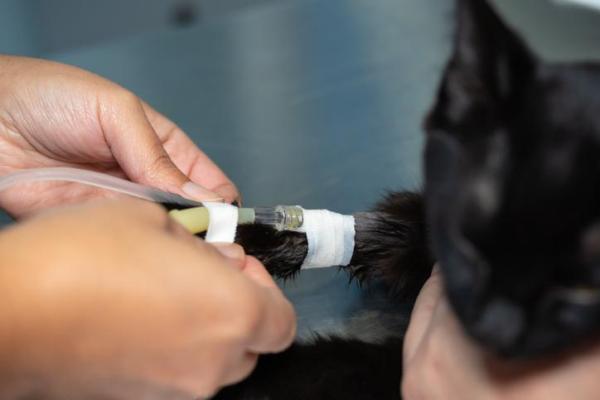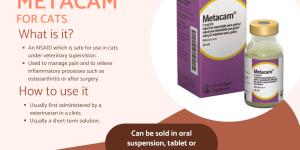Metoclopramide for Cats - Dosage, Uses and Side Effects



See files for Cats
Vomiting is a non-specific symptom which is associated with an extensive list of problems. These range from temporary nausea to life-threatening illness. Various drugs can be used to treat the underlying causes, resulting in the reduction of symptoms, including vomiting. Metoclopramide is a drug which is used to treat stomach and esophageal disorders, but it is important to know we cannot give it to our cat when we see them vomiting. We must go to a veterinarian to prescribe the drug as giving the drug without prescription could exacerbate symptoms or create new complications.
At AnimalWised, we look at metoclopramide for cats. We find out the dosage, uses, side effects and more of this drug.
What is metoclopramide for cats?
Metoclopramide is a drug which is mostly known for its antiemetic effect. This means it is a drug which acts to control vomiting and nausea. Metoclopramide also has an effect on intestinal motility, as well as counteracting gastric reflux. It is included in the group of drugs known as dopamine receptor antagonists (DRAs) or dopaminergic blockers.
There are two main mechanisms of action in metoclopramide for cats:
- Primary: its antiemetic action.
- Secondary: improves gastrointestinal movement.
The preparations of metoclopramide are the following (although not all are common in veterinary use):
- Oral solution
- Tablets
- Oral disintegrating tablets
- Intranasal spray
- Injectable solution (also for IV)
After oral administration, the maximum plasma concentration is reached after two hours. Metoclopramide has a half-life of 90 minutes. It crosses the blood-brain barrier. The injectable form of the drug can be given intramuscularly, subcutaneously or intravenously. Metoclopramide injections are usually only given in the clinical environment. Oral tablets or solution are much more common for home use.
Since it is a non-specific symptom, find out other causes of vomiting and diarrhea in cats with our related article.
Metoclopramide for cats uses
As an antiemetic and dopamine receptor antagonist, there are various uses of metoclopramide. However, there are not always the same for human and veterinary medicine, another reason it is important never to give drugs to your cat without prescription. The uses of metoclopramide for cats include treating the following symptoms:
- Vomiting
- Nausea
- Gastric reflux
- Slow intestinal motility
- Inability to empty stomach
The underlying causes of these symptoms are varied. They include chronic nephritis (kidney inflammation), intolerance to certain drugs and gastritis in dogs. The drug relieves nausea and gas accumulation, as well as promotes emptying of the stomach into the duodenum. When the vomiting is very intense and the cat is dehydrated, administering metoclopramide is insufficient and will require additional fluid therapy and intravenous medication.

Metoclopramide dosage for cats
The dose of metoclopramide in cats can only be established by the veterinarian. It will be based on the cat's weight and the condition from which they suffer. It is very important to determine accurate dosage of metoclopramide to best ensure effective and safe treatment.
As a general guide, metoclopramide injections are usually administered at 0.5 mg per kg of cat weight. This dose can be repeated every 6-8 hours, depending on the evolution of the problem. Metoclopramide oral solution for cats are administered between 1 and 2 per kg of cat weight, also every 6-8 hours. Six hours is the minimum time that can elapse between two doses. Dosage may be altered in cats with renal or hepatic insufficiency.
It is best to give metoclopramide before food. If the cat vomits it or produces a large amount of white foam, we must report it to the veterinarian. This happens in case it is necessary to change the preparation to the injectable form which cannot be rejected in the same way. The duration of treatment will depend on the evolution of the cat, although there is a limit. Generally, it is given an average of 3 to 7 days.
Contraindications of metoclopramide for cats
Metoclopramide should not be given to cats with intestinal obstruction, bleeding, or perforation. It is also not recommended for those diagnosed with epilepsy or with seizures. Any cat which has previously manifested an allergic reaction to metoclopramide is contraindicated for its use.
There are no studies on the safety of administering metoclopramide to pregnant or lactating cats. In these cases, administration will be at the veterinarian's discretion, based on an assessment of the advantages and disadvantages. If the cat is taking any medication and the veterinarian is unaware of it, we must notify them. Certain negative interactions or an increased risk of side effects could occur.
Learn more about feline pregnancy complications with our article on why a pregnant cat is leaking fluid.

Side effects of metoclopramide for cats
It is rare that metoclopramide causes any adverse effects. In a small percentage of cats we may be able to detect the following side effects:
- Nervousness
- Incoordination
- Abnormal postures and movements
- Prostration
- Aggression and behavior changes
- Sedation
- Drowsiness
- Tremors
- Diarrhea
- Excessive vocalizations
These symptoms normally disappear when the treatment is withdrawn. They can also occur when we exceed the recommended dose. In this case, it is advisable to keep the cat in a quiet place and notify the vet to determine the most appropriate action. There is no specific antidote, but metoclopramide is rapidly metabolized and eliminated. This means these side effects usually disappear within a short time.
Some cats could suffer allergic reactions. In prolonged treatments, constipation may appear. In any case, any sign the cat shows a potential negative reaction to the metoclopramide administration should be reported to the veterinarian. Finally, keep in mind that if your cat suffers from kidney or liver failure, the risk of suffering adverse effects increases. The vet will adjust the dose to avoid it as much as possible.

This article is purely informative. AnimalWised does not have the authority to prescribe any veterinary treatment or create a diagnosis. We invite you to take your pet to the veterinarian if they are suffering from any condition or pain.
If you want to read similar articles to Metoclopramide for Cats - Dosage, Uses and Side Effects, we recommend you visit our Medicine category.
1. American Society of Health-System Pharmacists. (2022). Metoclopramide. Retrieved from:
https://www.drugs.com/monograph/metoclopramide.html







